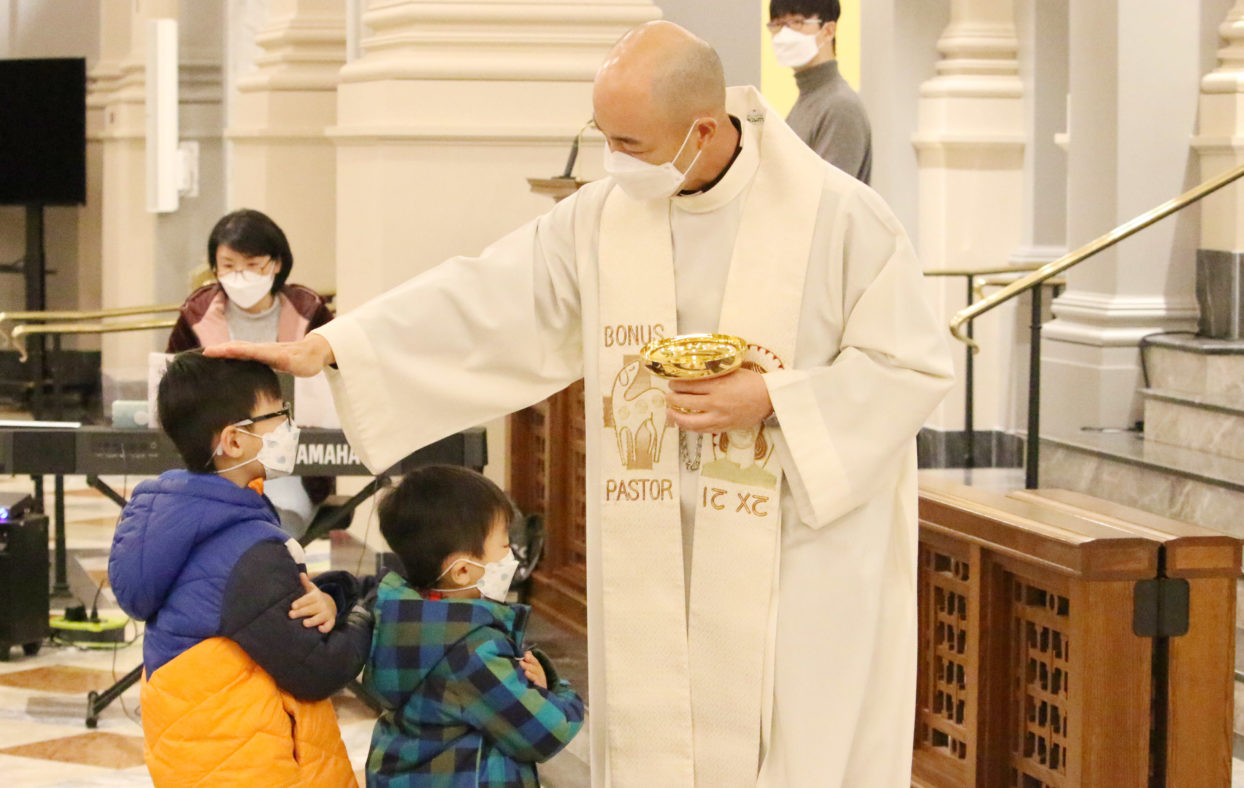Diocese of Knoxville is home to diverse groups of faithful who share and demonstrate a love for Christ
Story by Dan McWilliams
Photos by Dan McWilliams, Bill Brewer, and Stephanie Richer
The Diocese of Knoxville is made up of many different Mass communities, more than just the English/Roman rite that so many attend.
Mass is celebrated throughout East Tennessee in Spanish, Tagalog (Filipino), Korean, Polish, and Vietnamese, and there are extraordinary form/ Latin and Byzantine rites being celebrated as well.
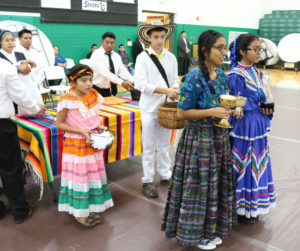 At least three churches in the diocese — the Cathedral of the Most Sacred Heart of Jesus, the Basilica of Sts. Peter and Paul in Chattanooga, and Holy Ghost Church in Knoxville — have three or more Mass communities under one roof.
At least three churches in the diocese — the Cathedral of the Most Sacred Heart of Jesus, the Basilica of Sts. Peter and Paul in Chattanooga, and Holy Ghost Church in Knoxville — have three or more Mass communities under one roof.
“The United States is a land of immigrants,” Bishop Richard F. Stika said. “We always have been that way, since day one — even before our country was founded. If you look at the migration of Native Americans, some believe that they crossed the Bering Strait when the land masses were connected. One of the most beautiful things is that we are still a country of immigrants. Unfortunately, sometimes, that is forgotten. Mostly though, I don’t see that here. I see people who are open to the beauty various cultures bring us. It’s even more beautiful when we can also worship that way.
“When I first arrived here almost 13 years ago, I was surprised to see that there was a Filipino Mass, and a Korean Mass, and, of course, Spanish Masses. We have added Polish Masses. And the Vietnamese Catholic community continues to grow. With the Vietnamese community, there are a lot of first-generation parents, and even grandparents, here. I asked those parishes and their pastors to respect their culture and languages when shaping their parish communities. I know with myself, personally, my parents spoke German and Polish, but my mom never taught us Polish because they wanted us to be American. This, too, is understandable, but I also think the beauty of our faith is that we can worship in these different ways — together as a universal Church.
“We have a cultural diversity in this diocese, with people living here from all over the world. South America and Central America — our Latino community is made up of Guatemalans, Hondurans, and folks from Mexico and Colombia. We are also more far-reaching, with communities that are from Vietnam and Poland. It just shows the beauty of the Church. I am excited to expand it wherever I can, and I am grateful for the missionary priests who are part of the diocese, like Father Marcin (Gladysz) who is a member of this diocese now, and also the priests from religious communities that serve with us —— like those from Africa and India.”
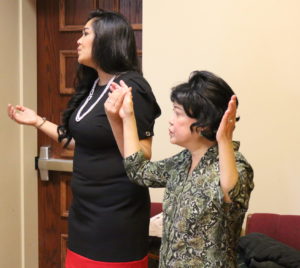 The Cathedral of the Most Sacred Heart of Jesus is home to five Mass communities.
The Cathedral of the Most Sacred Heart of Jesus is home to five Mass communities.
“I am proud that the cathedral parish reflects the universality of the Catholic Church,” said its rector, Father David Boettner. “Each month, we celebrate Mass in English, Spanish, Korean, Tagalog (Filipino), and Polish. In addition, the students in the cathedral school speak over 13 different languages. We also offer English as a second language classes as well as citizenship classes. It is a wonderful gift to celebrate the unique cultures and languages that are a part of the Church.”
Holy Ghost in North Knoxville has English, Latin, and Hispanic Mass communities.
“The most notable thing I have observed about Holy Ghost Church is its diversity,” said its pastor, Father Bill McNeeley. “In addition to the established families who have been parishioners when this church was established or whose families have been in East Tennessee for generations, there is an incredible diversity of nationalities, cultures, and races. Within our Hispanic community, there are at least seven or eight Central and South American countries represented. They have their own language dialects, though Spanish is their common second language.
“Similarly at least five or six African countries are represented here, with Swahili being their common, mostly second language. Additionally, there is a mixture of Filipino, Polynesians, and other Asians that all make up this one parish. The image that kept coming to mind is that of a ‘community of communities.’”
“(The challenge is to) give this parish some cohesion so that we do not become 10 or 12 different communities or even congregations that happen to occupy the same building on Sundays,” Father McNeeley said.
The Mass in Korean: It ‘matters to us’
 Father Seon Dobang comes from the Diocese of Nashville to the Cathedral of the Most Sacred Heart of Jesus twice a month to celebrate a Mass for the Korean community. Their numbers are tiny because of COVID, but a handful of the faithful attend each first and third Saturday Mass.
Father Seon Dobang comes from the Diocese of Nashville to the Cathedral of the Most Sacred Heart of Jesus twice a month to celebrate a Mass for the Korean community. Their numbers are tiny because of COVID, but a handful of the faithful attend each first and third Saturday Mass.
“It means a lot,” said Matt Lee, the Korean community Mass coordinator. “The English Mass and the Korean Mass — theologically it’s the same. But having a Catholic community and speaking the same language — we gather together, we worship together, we pray together in the language that we feel the most comfortable — matters to us.”
Mr. Lee said that he feels “really bad that after COVID our community is getting smaller and smaller. I’m really glad that this community continues, that our Father from the Nashville Korean Catholic church visits us. He used to come here once a month, but now he visits us twice a month, even before we were getting smaller, so I really appreciate what Father is doing for us.”
The Korean Mass numbers used to be much larger.
“When we were the biggest, we were like 60 to 70 people,” Mr. Lee said. “We were big enough to say that we want to use this space, big enough for the cathedral. … I pray we’ll become bigger again.”
A Korean Mass community also exists at Our Lady of Perpetual Help Parish in Chattanooga.
The Mass in Tagalog: To have ‘a sense of “belonging”’
 The Masses for the Filipino community in Knoxville have been going for more than a decade and will again take place monthly at the Cathedral of the Most Sacred Heart of Jesus when the COVID situation allows.
The Masses for the Filipino community in Knoxville have been going for more than a decade and will again take place monthly at the Cathedral of the Most Sacred Heart of Jesus when the COVID situation allows.
The Filipino community celebrates more than just monthly Masses; it also participates in special events.
“Every January, we celebrate Sinulog, the feast of Santo Niño, the child Jesus,” said Ling Catuncan of the Filipino Mass community. “Every June, we celebrate the Philippines’ Independence Day. In August, we are a great part of the Asian festival. In November, our FACCET (Filipino American Christian Community of East Tennessee) has its anniversary, and every December we do caroling to our Fil-Am community homes to celebrate a usual Filipino tradition. We have been part of some churches’ performances as well — Filipinos are very talented, you know.”
Father Albert Sescon, a Diocese of Knoxville priest and a native of the Philippines, is the celebrant of most of the Filipino Masses.
Having the Mass in Tagalog gives the Filipino community “a sense of ‘belonging,’” Ms. Catuncan said, “especially to members who haven’t been back home to the Philippines in ages. It also helps our young members, especially our youth group, learn our language and enjoy singing in Tagalog.”
The Filipino Mass community has grown considerably from its humble beginnings.
“We started with a few families attending our monthly Masses, and by word of mouth, we probably have 200-plus families attending our monthly gathering now,” Ms. Catuncan said.
Ms. Catuncan addressed the outlook for the Filipino Mass community.
“We have made it to 10 years, and we look forward to more and more,” she said.
The Mass in Polish: ‘The language of their fathers’
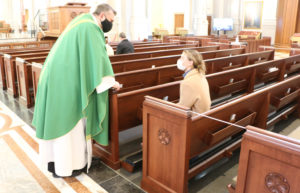 East Tennessee’s Polish community received a huge blessing in March 2018 when Cardinal Stanisław Dziwisz celebrated a Mass in Polish during the dedication weekend of the Cathedral of the Most Sacred Heart of Jesus.
East Tennessee’s Polish community received a huge blessing in March 2018 when Cardinal Stanisław Dziwisz celebrated a Mass in Polish during the dedication weekend of the Cathedral of the Most Sacred Heart of Jesus.
The next year, Father Marcin Gladysz came to the diocese as an associate pastor at the cathedral and now celebrates monthly Masses in Polish there.
“This is the reason why I am here in the Diocese of Knoxville, because the Polish community asked Bishop Stika for the Mass in Polish,” Father Gladysz said. “With the help of Cardinal Dziwisz, the former secretary of St. John Paul II, this information came to me. I was in Chicago, and I made the decision that I will come to be with the Polish community here in East Tennessee.”
The Mass in Polish is particularly important to one segment of the faithful, Father Gladysz said.
“You have to remember that the first generation, especially the first generation of people coming from the old country to the United States, they are still praying in the language of their fathers,” he said. “For them, this is important. It’s not just helping their faith; this also is more the culture.
“I had the first and second Polish Masses two years ago. So many people were crying, saying, ‘You know, Father, this is the first time after 20, 25 years that I pray and sing again in Polish.’ Today [at the Feb. 7 Mass in Polish], I finished Communion, and I was ready to make the post-Communion prayer, but people still were trying to sing more and more and more. It makes the heart warm to remember their old memories from their childhood in Poland. I think this is why Mass in Polish, the language they make their prayers in, their morning prayers, the language their parents learned, the Our Father and Hail Marys — it’s important.”
Numbers at the Feb. 7 Mass were a little more than 50, lower than normal because of COVID.
“Before the COVID pandemic, the best number was 160,” Father Gladysz said.
While the Mass in Polish is important for the first-generation Polish families, for later generations the Mass is an important step in “taking care of their heritage,” Father Gladysz said, “to remember where we are from.”
 “I meet so many Polish-Americans, like fifth- or sixth-generation,” he continued, “they are not speaking Polish anymore, but they remember some Polish food, they are coming sometimes to the Polish Mass to hear this language because this is important for them. This is their heritage. The future is to take care of their Polish heritage.”
“I meet so many Polish-Americans, like fifth- or sixth-generation,” he continued, “they are not speaking Polish anymore, but they remember some Polish food, they are coming sometimes to the Polish Mass to hear this language because this is important for them. This is their heritage. The future is to take care of their Polish heritage.”
Kasia Golec of Knoxville helped organize that first Mass in Polish with Cardinal Dziwisz.
“We are growing tremendously,” she said of the community. “We have a Facebook [page] — it’s called Polonia w Knoxville, Tennessee. We put all information regarding the Polish community here. I have Polish people contacting me from all states asking me how to move to Knoxville, Tennessee.”
Mrs. Golec currently is “in the process of moving a family from California to Knoxville.”
“They are so excited,” she said. “They will be here [this month]. I will show them around. I will show them the church, everything. They’re going to look for a house.”
Mrs. Golec said their faith is a significant factor in the family’s move from the west coast to Knoxville.
“They also want to be close to a Polish community.”
Mrs. Golec’s goal “is to have a Polish Mass every weekend and have a Polish school for the kids we have here. We just need more Polish people. That’s why I’m so eager to help everyone who will contact me to bring them here to Knoxville.”
Camille Kwasniak is a 20-year-old University of Tennessee student majoring in elementary education.
“I’m 100 percent Polish,” she said.
“I grew up speaking Polish. I’m from Chicago. But I love Tennessee. I visited here once and fell in love with it.”
She has been visiting different Catholic churches in Knoxville and on Feb. 7 was attending the Mass in Polish for the first time.
“One of my mom’s friends saw online the Diocese of Knoxville’s Polish Mass and suggested I check it out. So, this is my first time here. It is beautiful, just gorgeous. This is like a little part of home for me. Back at home we only go to the Polish church.”
Ms. Kwasniak speaks Polish fluently.
“That was my first language growing up.”
Andrew Cieslik, a member of the parish council at St. John Neumann in Farragut, is a native of Lodz, Poland.
He says having the Mass in Polish is “awesome.”
“It’s a super situation. We were very lucky, and we are very thankful to Bishop Stika that he made the arrangement with Father Marcin, because we really needed it. Myself and my wife and my kids have been in Tennessee since 1993, for a while, and we didn’t have a Polish priest for a very, very long time, until two years ago.”
Mr. Cieslik said the Polish community is growing, even drawing Mass-goers from neighboring states.
“There are more and more people coming. It’s like any other community — definitely the presence of Father Marcin helps us,” he said. “There are quite a few folks who are coming here because they knew him or heard about him from Chicago. There are some folks who moved from the Chicago area here to Knoxville and the vicinity.”
The Mass in Vietnamese: ‘It brings the people back to the culture’
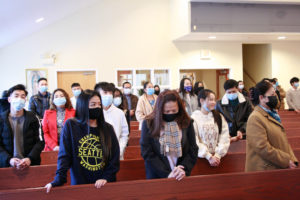 The Vietnamese Catholic community began forming in Knoxville in the late 1980s and early 1990s. In June 2012, Divine Mercy Catholic Mission formed in Knoxville. In 2013, Divine Mercy became the diocese’s 49th parish. It is now led by Father Dominic Nghia Nguyen, CRM, and Deacon Hieu Vinh, and has more than 300 members from Knoxville and surrounding areas.
The Vietnamese Catholic community began forming in Knoxville in the late 1980s and early 1990s. In June 2012, Divine Mercy Catholic Mission formed in Knoxville. In 2013, Divine Mercy became the diocese’s 49th parish. It is now led by Father Dominic Nghia Nguyen, CRM, and Deacon Hieu Vinh, and has more than 300 members from Knoxville and surrounding areas.
Established by Bishop Stika in summer 2019, the St. Faustina Public Association of the Faithful is a flourishing Vietnamese community in the Chattanooga area. The bishop celebrated Mass for some 240 attendees at Notre Dame High School on Nov. 3, 2019. Father Nick Tran is the chaplain for the community.
“I challenged those (Divine Mercy) folks,” Bishop Stika said. “They wanted their own parish. For a while, they were at Knoxville Catholic High School, and now they have their own parish. It’s the same thing now in Chattanooga. They have a place where they worship. It’s a brand-new community coming together. I was able to secure a Vietnamese priest from the Archdiocese of Hartford to help lead the Vietnamese community in Chattanooga. I am hopeful that maybe he can join us [permanently], because he is a marvelous example of what is possible here in this diocese.”
Having the Mass in Vietnamese for the faithful “brings the people back to the culture and the activity for the Vietnamese people,” Father Nguyen said. “When we came here, we adapted to America. It really helps the people to reach back to our culture so that the next generation can know our culture.”
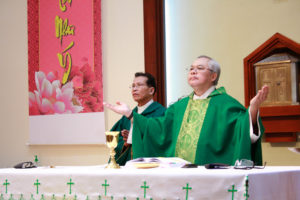 Anthony Le is a parishioner of Divine Mercy.
Anthony Le is a parishioner of Divine Mercy.
“My original language is Vietnamese, and when I attend English Masses it’s kind of hard for me to convey the words from the father, so I prefer the Masses in my own language so I can understand more God’s words,” Mr. Le said, “and he can explain it to me better and I understand better in my own language, so that’s why I prefer this.”
Mr. Le, 21, was born in Vietnam and came to America five years ago.
Divine Mercy Parish “has helped me in a lot of ways,” Mr. Le said. “It has helped me through many hardships, and through that I help a lot of other people.”
The Mass in Spanish: ‘We feel that we belong to the greater community’
 The story of Catholic Hispanic Ministry in East Tennessee dates back to the 1540 Hernando de Soto expedition. Regular Masses were established in the Diocese of Nashville in the late 1980s and expanded from there as the Diocese of Knoxville was born in 1988.
The story of Catholic Hispanic Ministry in East Tennessee dates back to the 1540 Hernando de Soto expedition. Regular Masses were established in the Diocese of Nashville in the late 1980s and expanded from there as the Diocese of Knoxville was born in 1988.
In 2019, before the pandemic, the communities with the largest weekly Mass attendance were the Cathedral of the Most Sacred Heart of Jesus in Knoxville, with 942 attending, and Our Lady of Perpetual Help in Chattanooga (839).
Currently, 28 parishes out of 51 offer Mass in Spanish on Sundays.
“To have Mass in Spanish is such a blessing for anybody whose mother tongue is Spanish,” said Blanca Primm, director of Hispanic Ministry for the diocese. “The majority of us come from a Catholic family with the custom and tradition to go to Mass with our family back home, our first home. We feel at home when we go to Mass here, but when it is in Spanish, especially, we feel that we belong to the greater community when we understand what is proclaimed.
“In East Tennessee, the majority of Hispanic immigrants, or, to be more specific, the Hispanic head of households, are first-generation immigrants. I identify myself with that reality. We learned to pray in Spanish when we were growing up, from our mothers, aunts, and grandmothers.
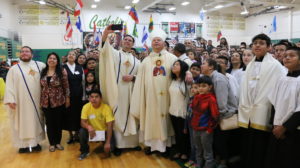
Bishop Richard F. Stika (center), is joined by Father Rafael Capó (taking selfie) of the Archdiocese of Miami, Father Julián Cardona (left), associate pastor of St. Thomas the Apostle Parish in Lenoir City, Blanca Primm (second from left), director of Hispanic Ministry for the Diocese of Knoxville, and Hispanic parishioners of the Diocese of Knoxville following a diocesan-wide Hispanic Mass for the V Encuentro.
“Most of the first-generation immigrants, even if we knew how to speak English, we feel more at home in church if we listen to the liturgy and participate in Spanish. We live the liturgy more fully. Since our most inner longings and what comes from our hearts are deeply connected with our language and thoughts, we immediately relate in communicating with God, our Father, in our mother tongue. I must say that for many of our brothers and sisters from Guatemala and from some areas in Mexico, Spanish is their second language, since they speak other Indian dialects. Also, I think that it is important to mention that one way that the Hispanic community feels united among our diversity of cultures is through the Spanish liturgy.”
For Hispanics, “to go to Mass in Spanish is to savor our faith, the words, the prayers, in Spanish [so that] we live Mass to the fullest. That is why I think that it is paramount to offer the holy Mass in our language,” said Sister Angelica Lopez, a Missionary Sister of the Sacred Heart of Jesus “Ad Gentes” serving at Notre Dame Church in Greeneville and at St. Anthony of Padua in Mountain City.
The Basilica of Sts. Peter and Paul has a vibrant Hispanic community, said its rector, Father David Carter.
“If there is any community that has more life, vitality, unity of purpose, and dedication — I don’t know it,” he said. “Our Hispanic community, the basilica in particular, is very unified, very community-centered. They are for each other. You see it happen all the time. When tragedy strikes, they come together as a community. They take care of each other. It’s very beautiful to see.”
The Byzantine Catholic community: Services ‘feed the people’
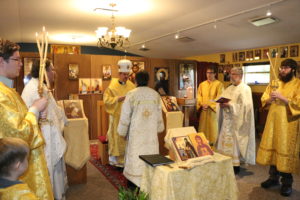 The St. Thomas the Apostle Eastern (Byzantine) Catholic Mission meets for Divine Liturgy in Knoxville every first, second, and fourth Sunday. Father Richard Armstrong is the pastor of the community.
The St. Thomas the Apostle Eastern (Byzantine) Catholic Mission meets for Divine Liturgy in Knoxville every first, second, and fourth Sunday. Father Richard Armstrong is the pastor of the community.
“There was a Byzantine family who was originally from New York who moved to Tennessee over 30 years ago,” Father Armstrong said.
“There were no Byzantine churches anywhere in Tennessee. They started up some mission churches with little success because they were only served by visiting clergy from up north or by bi-ritual priests who knew very little about the Byzantine tradition.
The first Divine Liturgies held with a full-time priest were held at the Chancery beginning in 2009. The parish moved to the basement of an Anglican church and finally acquired its own property in 2014. With its own property and more services, the community grew, Father Armstrong said. About seven regular families attend Divine Liturgies now, he said, with the number of visitors being down because of COVID.
Having the Divine Liturgy for the Byzantine faithful “is what feeds the people,” Father Armstrong said. “For a Byzantine, liturgy is his identity. About half of our congregation grew up Byzantine. The rest are converts.”
The Byzantines “love sharing our tradition with non-Byzantines,” Father Armstrong said. “We celebrated a Divine Liturgy at St. Therese Parish in Clinton in the fall of 2020 and on Feb. 21, 2021, at St. Joseph Parish in Norris. Both Latin-rite communities were especially interested and excited to learn about their Catholic brothers and sisters from another tradition.”
Father Armstrong also serves as parish administrator of St. Joseph and St. Therese.
Father Thomas O’Connell formerly celebrated Divine Liturgies for Holy Resurrection Ruthenian Byzantine Catholic Mission, at Holy Family Church in Seymour and at Holy Ghost in Knoxville.
The Mass in Latin: ‘People are drawn to that “mystery that elevates”’
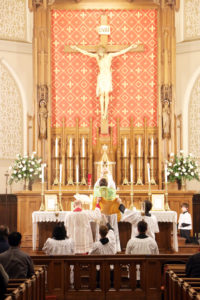 The traditional Latin Mass came back to the Diocese of Knoxville in early 2004, when Bishop Joseph E. Kurtz granted an indult, which gave special permission required for celebration of the older form of the Mass. Ecclesia Dei adflicta, Pope St. John Paul II’s 1988 motu proprio (“at his own initiative”) “gave people who were desirous of the Latin Mass an opportunity to celebrate it,” said Father David Carter, rector of the Basilica of Sts. Peter and Paul in Chattanooga.
The traditional Latin Mass came back to the Diocese of Knoxville in early 2004, when Bishop Joseph E. Kurtz granted an indult, which gave special permission required for celebration of the older form of the Mass. Ecclesia Dei adflicta, Pope St. John Paul II’s 1988 motu proprio (“at his own initiative”) “gave people who were desirous of the Latin Mass an opportunity to celebrate it,” said Father David Carter, rector of the Basilica of Sts. Peter and Paul in Chattanooga.
“That indult started, and I know they did one at St. Stephen in Chattanooga with Father P.J. McGinnity, and they started one at St. John Neumann — Father John Arthur Orr was the original chaplain. Those were the two indult Masses that we had in the diocese,” Father Carter continued. “Then in 2007, the use of the Latin Mass was liberalized by Pope Benedict XVI in his motu proprio Summorum Pontificum, and now we have multiple Masses, because any priest can say it, and the faithful, if they gather together in a stable group, can ask for it, and priests should be generous in providing that Mass for them.”
Father McGinnity and the Latin Mass moved to St. Thérèse of Lisieux Parish in Cleveland, and Father Carter also came down from Knoxville to Cleveland to celebrate the liturgy.
“There was a similar one that was going on at St. Mary’s in Johnson City, and on the weekends that I wasn’t driving to Cleveland, I was driving to Johnson City to offer that in the afternoons,” Father Carter said. “And all the while, it was at St. John Neumann, then it moved to St. Therese in Clinton with Father John Orr, and then it found its current home at Holy Ghost in Knoxville. That’s where the Knoxville Latin Mass community exists.” Today, the Latin Mass is celebrated weekly at the Basilica of Sts. Peter and Paul in Chattanooga, at Holy Ghost Church in Knoxville, at St. Mary in Athens, and at St. Mary in Johnson City, plus most Thursdays at St. Mary in Oak Ridge.
“We’ve seen a huge increase” in attendance, Father Carter said of the Latin Mass. “When I started at St. Thérèse in Cleveland, there were, let’s say, about 50 to 75 people who would be in attendance. By the time I stopped doing that Mass, it was about 100 people. When I came to the basilica, a lot of those families gravitated toward the basilica because they lived in Chattanooga and were driving up to Cleveland, and the Latin Mass there in Cleveland shrank.
But we started offering a Latin Mass at the basilica, and now it’s grown to be one of our larger Masses. We get from 200 to 250 people at the Latin Mass every Sunday.”
Having the Mass in Latin for the faithful “is an expression of mystery,” Father Carter said.
“Sometimes when a man woos a woman, he’ll speak to her in French. That somehow melts her heart, that she’s being spoken to in a language that she doesn’t understand the content of, at least as far as the syntax, but she understands the intention behind it, and that it’s good,” he said. “I think there are a lot of people who are drawn to that ‘mystery that elevates,’ because it obviously is an ancient language that tells us that this is something not just for our own day and age, but it’s something that takes us all the way back into antiquity and has a connection with the Apostles, the apostolic tradition.
“You know, Pontius Pilate spoke Latin. There was Latin written on the cross of Christ. So there’s this connection with the ancestors who have gone before us, and it’s a sense of belonging to something bigger than just our local community.”
Those who remember when the Mass in Latin was the only Mass there was, before Vatican II, are shrinking in number.
“The majority of people who come to the Latin Mass at the basilica on Sundays are young people: tons of college-age students, tons of young families just starting off, tons of families with small children. The baby noise, the child noise, that happens during that Mass is very palpable,” Father Carter said. “You can sense that there’s a lot of youth and vitality of people coming to the Latin Mass. People say, why is that? They didn’t know it. I think, in this day and age where there’s so much transition and so much fluidity, people are looking for something that’s solid and lasting.
“You know how people, when the stock market gets a little bit fickle, they go and invest in gold, because they know that something solid has value that will last and perdure. I think that’s what people are doing with the Latin Mass — they’re trying to invest in something that doesn’t change. There’s a constancy to it, and that is something that helps them through the storms of this life.”
The Latin Mass community is trying to exemplify the joy of tradition, Father Carter said.
“There is a sometimes fair and sometimes unfair assessment that people attached to the Latin Mass are curmudgeons or sad,” he said. “What we want to show is that the folks who come to our Mass are very vibrant and evangelical and joyful. That’s what I see. And to change hearts and minds by a joyful witness and an inviting and welcoming environment that says, ‘Come experience the joy that we experience.’ That’s our goal.”
The Latin Mass is “perennial,” Father Carter said.
“That’s the nature and the draw of the Latin Mass, that it doesn’t change with fads,” he said. “It doesn’t change with different movements in the world. It’s a little bit more resistant to the waves of change. I see it having kind of an anchoring effect for the Church and for the parish and for the faithful for many years to come.”

